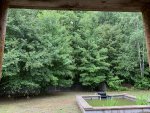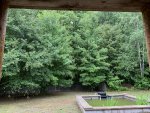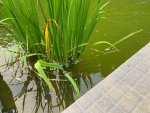- Joined
- Sep 13, 2019
- Messages
- 3
- Reaction score
- 1
- Location
- Marquette, Michigan
- Hardiness Zone
- 5a
- Country

We recently purchased a home that came with a 12x12 foot pond that is up to 5 feet deep in the center. Here are a few details about our setup:
 Here are my questions:
Here are my questions:
- Supposedly they had 40 koi that were all ~2 feet long that died this past winter. They stocked it with ~20 goldfish of various sizes and 2 small koi so that's all we have in there.
- It has a large filter box with 4-5 different sections in it and waterfalls back into the pond.
- When we took possession of the home in June the pond was already pretty green. We have put some algaecide in there but can only see ~6" down.
- We live in the U.P. of Michigan, so way up there!
- For the winter, what do I need to purchase? I'm assuming the filter would freeze and the filter box would crack. Do I need a bubbler? A de-icer? Is there something that won't be super expensive?
- Is there anything I should do to try to get the water more clear, or wait until spring when we plan to drain, clean, and re-fill it?




